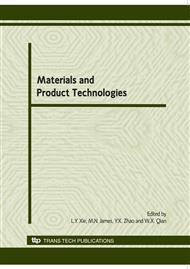[1]
T. Zhang, X.Y. Wu, B. Guo and Y.J. Tan: Operational availability model for repairable system under (m, �G) maintenance policy. Journal of systems engineering (2007).
Google Scholar
[2]
S.R. Chakravarthy: Analysis of a k-out-of-� system with spares, repairs, and a probabilistic rule. Journal of Applied Mathematics and Stochastic Analysis (2006).
Google Scholar
[3]
M.S. Moustafa: Availability of k-out-of-n: G System with M Failure Modes. Microelectronics Reliability (1996).
Google Scholar
[4]
B.B. Fawzi, A.G. Hawkes: Availability of an R out of � system with spares and repairs. Journal of Application Probability (1991).
Google Scholar
[5]
T.L. Zhang: Availability of 3-out-of-4: G Warm Standby System. IEICE TRANS (2000).
Google Scholar
[6]
E. Frostig, B. Levikson: On the availability of R out of � repairable systems. Naval Research Logistics (2002).
DOI: 10.1002/nav.10025
Google Scholar
[7]
Y. Barron, E. Frostig and B. Levikson: Analysis of R out of � systems with several repairmen, exponential life times and phase type repair times: An algorithmic approach. European Journal of Operational Research (2006).
DOI: 10.1016/j.ejor.2004.06.005
Google Scholar
[8]
S.R. Chakravarthy, A. Gómez-Corral: The influence of delivery times on repairable k-out-of-� systems with spares. Applied Mathematical Modelling (2009).
DOI: 10.1016/j.apm.2008.07.007
Google Scholar
[9]
A. Khatab, N. Nahas and M. Nourelfath: Availability of K-out-of-�: G systems with non-identical components subject to repair priorities. Reliability Engineering & System safety (2009).
DOI: 10.1016/j.ress.2008.02.017
Google Scholar
[10]
Z.Y. Jia, R. Kang, N.C. Wang and X.N. Sun: Complicated Mission Success Modeling of the Partially Repairable System. The Proceedings of 2009 8th International Conference on Reliability, Maintainability and Safety (2009).
DOI: 10.1109/icrms.2009.5270199
Google Scholar
[11]
Z.H. Zheng, L.R. Cui and A. G. Hawkes: A Study on a Single-Unit Markov Repairable System with Repair Time Omission. IEEE Transaction on Reliability (2006).
DOI: 10.1109/tr.2006.874933
Google Scholar
[12]
H.X. Li, X.Y. Meng and N. Li. An availability analysis of series repairable system with repair time omission. Journal of Yanshan University (2007).
Google Scholar
[13]
Y. Pang, H.Z. Huang, Y. Liu, Q. Miao and Z.L. Wang. Reliability Analysis of a Repairable Parallel System with Repair Time Omission. The Proceedings of 2009 8th International Conference on Reliability, Maintainability and Safety (2009).
DOI: 10.1109/icrms.2009.5270242
Google Scholar
[14]
Cao Jinhua, Cheng Kan. Introduntion of Reliability Mathematics (Higher Education Press, Beijing 2006).
Google Scholar


